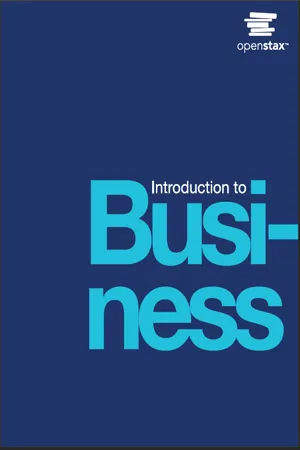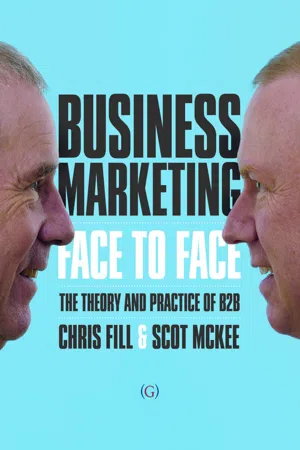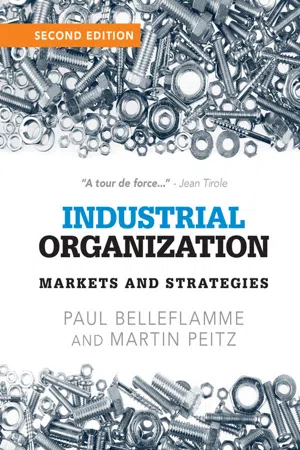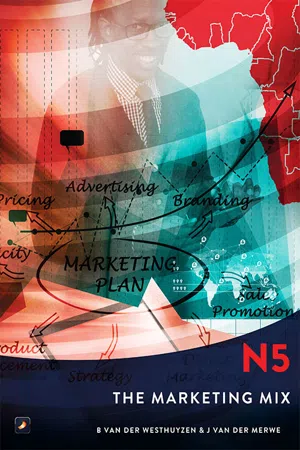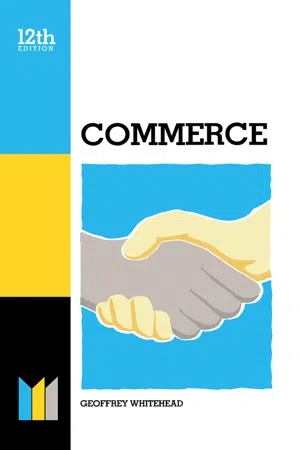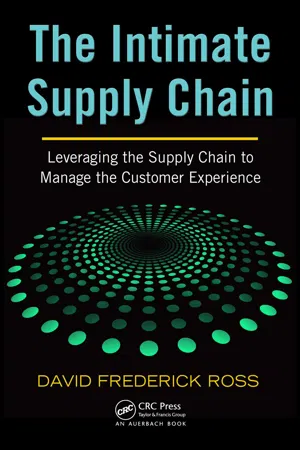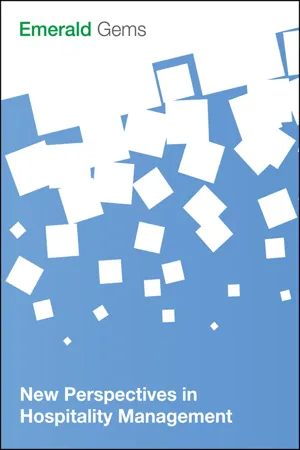Marketing
Intermediaries
Intermediaries are third-party entities that facilitate the distribution of products from the manufacturer to the end consumer. They can include wholesalers, retailers, and distributors. Intermediaries play a crucial role in bridging the gap between producers and consumers, often providing services such as storage, transportation, and marketing to help bring products to market.
Written by Perlego with AI-assistance
Related key terms
1 of 5
12 Key excerpts on "Intermediaries"
- eBook - PDF
- Lawrence J. Gitman, Carl McDaniel, Amit Shah, Monique Reece, Linda Koffel, Bethann Talsma, James C. Hyatt(Authors)
- 2018(Publication Date)
- Openstax(Publisher)
We will look first at the entities that make up a distribution channel and then examine the functions that channels serve. Marketing Intermediaries in the Distribution Channel A distribution channel is made up of marketing Intermediaries, or organizations that assist in moving goods and services from producers to end users and consumers. Marketing Intermediaries are in the middle of the distribution process, between the producer and the end user. The following marketing Intermediaries most often appear in the distribution channel: • Agents and brokers: Agents are sales representatives of manufacturers and wholesalers, and brokers are entities that bring buyers and sellers together. Both agents and brokers are usually hired on commission basis by either a buyer or a seller. Agents and brokers are go-betweens whose job is to make deals. They do not own or take possession of goods. • Industrial distributors: Industrial distributors are independent wholesalers that buy related product lines from many manufacturers and sell them to industrial users. They often have a sales force to call on purchasing agents, make deliveries, extend credit, and provide information. Industrial distributors are used in such industries as aircraft manufacturing, mining, and petroleum. • Wholesalers: Wholesalers are firms that sell finished goods to retailers, manufacturers, and institutions (such as schools and hospitals). Historically, their function has been to buy from manufacturers and sell to retailers. • Retailers: Retailers are firms that sell goods to consumers and to industrial users for their own consumption. Chapter 12 Distributing and Promoting Products and Services 461 Exhibit 12.2 A Typical Supply Chain (Attribution: Copyright Rice University, OpenStax, under CC BY 4.0 license.) At the end of the distribution channel are final consumers and industrial users. Industrial users are firms that buy products for internal use or for producing other products or services. - eBook - PDF
Marketing Management N5 SB
TVET FIRST
- J Wiehan I Govender(Author)
- 2018(Publication Date)
- Macmillan(Publisher)
• At the right place. • In the right condition. • At the right time. • In the correct quantity. • At the right cost. Intermediaries: • Are often independent businesses that form part of a distribution or marketing channel. • Help the business to move its products until they get to consumers. • Can include delivery companies that physically move products from the warehouse to the retail stores. • Can also include branding and packaging companies, as well as wholesalers and retail stores that sell the product for the business. • Add value to a business through their experience, contacts and knowledge. Example 2.1: A soft-drink distribution channel How does Coca-Cola get its products to its customers? Coca-Cola manufactures and sells concentrates, beverage bases and syrups. It also takes care of its own marketing and branding. Unit 2.1: 2.1.1: distribution or marketing channel: a chain of interdependent organisations through which businesses make their products or services available to consumers Intermediaries: individuals or organisations in the distribution channel that serve as middlemen to make a product or service available from the manufacturer to the consumer 78 Module 2 Example 2.1: A soft-drink distribution channel (continued) However, the business works with Intermediaries for other processes such as bottling, packaging, merchandising and transportation. Coca-Cola does not sell the finished product directly to its customers – you cannot buy Coke from the factory. It uses Intermediaries such as wholesalers (for example Makro), retailers (for example Checkers) and other vendors to sell its products to consumers. The influence of distribution decisions Distribution involves making important decisions about who the product or service’s target market is, which Intermediaries to use, and how to transport products. Figure 2.2 shows the marketing factors that influence distribution decisions. - eBook - PDF
- Chris Fill, Scot McKee(Authors)
- 2011(Publication Date)
- Goodfellow Publishers(Publisher)
Their participation in the physical, ownership, negotiation, finance, payment and promotion flows delineates their significance in the marketing channel. Their role is instrumental in stimulating the channel to respond to end-user customer needs. Intermediaries The term ‘intermediary’ refers to all those organisations that link together manu-facturers and end-users. The overall role is acting as a go-between to ensure that end-users are able to access the products and services they require in quantities and locations that provide greatest utility. In Bucklin’s terms, Intermediaries seek to provide optimum levels of service outputs. There are many types of intermediary but the most common are wholesalers, merchants, brokers, manufacturers’ representatives, dealers, distributors, agents, retailers and value added resellers. Many of these perform similar functions but the terminology reflects market needs and historical precedent. Essentially there are two main types of intermediary, wholesalers and retailers. Wholesalers The term ‘wholesalers’ embraces merchants, brokers, manufacturers representa-tives, agents, distributors and dealers. They are (normally) independently owned and either buy, or facilitate the transfer, of products from producers and resell them to retailers, other wholesalers and end-user business customers. They perform tasks that assist producers (upstream) and they also perform tasks that assist their customers (downstream). These tasks are set out in Table 6.3. There is a small technical difference between a wholesaler and a distributor. A wholesaler distributes products to other Intermediaries but distributors sell directly to end-user customers, invariably business customers. This difference is to be noted but this text focuses on wholesalers as if they encompass distributors. The role of wholesalers is linked to the tasks they perform in order that the channel operates efficiently. - eBook - PDF
- Charles Lamb, Joe Hair, Carl McDaniel, , Charles Lamb, Charles Lamb, Joe Hair, Carl McDaniel(Authors)
- 2020(Publication Date)
- Cengage Learning EMEA(Publisher)
This benefit to customers accrues whether the retailer operates in a physical store location or online. 13-6c Channel Functions Performed by Intermediaries Intermediaries in market- ing channels perform three essential functions that en- able goods to flow between producer and consumer. Transactional functions involve contacting and communicating with pro- spective buyers to make them aware of existing merchant wholesaler an institution that buys goods from manufacturers and resells them to businesses, government agencies, and other wholesalers or retailers and that receives and takes title to goods, stores them in its own warehouses, and later ships them agents and brokers wholesaling Intermediaries who do not take title to a product, but facilitate its sale from producer to end user by representing retailers, wholesalers, or manufacturers retailer a channel intermediary that sells mainly to consumers 239 CHAPTER 13: Supply Chain Management and Marketing Channels Copyright 2021 Cengage Learning. All Rights Reserved. May not be copied, scanned, or duplicated, in whole or in part. Due to electronic rights, some third party content may be suppressed from the eBook and/or eChapter(s). Editorial review has deemed that any suppressed content does not materially affect the overall learning experience. Cengage Learning reserves the right to remove additional content at any time if subsequent rights restrictions require it. products and to explain their features, advantages, and benefits. Intermediaries in the channel also provide lo- gistical functions. Logistical functions typically include transportation and storage of assets, as well as their sort- ing, accumulation, consolidation, and/or allocation for the purpose of conforming to customer requirements. - Bonita Kolb, Bonita M. Kolb(Authors)
- 2020(Publication Date)
- Routledge(Publisher)
Indirect distribution uses channel Intermediaries, or other people and organizations, to sell the product to consumers. This can greatly increase the number of consumers who have the opportunity to conveniently purchase the product. However, the intermediary will also need to make a profit on the sale of the product. Either the producer must sell the product more cheaply to the intermediary so that once it is marked up the price will still be the same as it was originally, or the final retail price will be higher. To use an intermediary, the producer must understand the process involved in selling the product to retailers.Formerly the organization had to decide if they should distribute through stores or online. Now, the question is no longer relevant as the bricks and mortar and online worlds have merged. Retail stores that formerly had a separate ecommerce and physical store marketing division have now merged them into one. Shoppers make no distinction between buying online and onsite. They will use both based on convenience (LaFleche 2019). A consumer may use a company’s website that shows photos of the product and describes the product details for research. They may then purchase in a store. Or, they do the opposite, researching in a store but then buying online.Distribution challenges—not as easy as you would think
The problem that distribution addresses is that the product may exist in one place while the consumer lives somewhere else. Intermediaries are the people and organizations that solve this problem. While this is easy to understand for tangible products, the issue is also the same for service products such as performances. In these cases, an agent is often used as an intermediary. The agent will book the venues where the entertainment takes place for either a flat fee or a percentage of the money earned by the entertainer. The reason an agent may be needed is that the agent has an established reputation with venues who do not want to make a mistake by booking talent that will not appeal to their customers.- eBook - PDF
Strategic Marketing Management in Asia
Case Studies and Lessons across Industries
- Syed Saad Andaleeb, Khalid Hasan(Authors)
- 2016(Publication Date)
- Emerald Group Publishing Limited(Publisher)
2 Since these activities can involve considerable risk and responsibility, it is clear that, in attempting to ensure the availability of their goods, producers must consider the needs of channel Intermediaries as well as those of the end consumers. The Basics of a Marketing Channel System The distribution environment : As more tasks are assigned to inter-mediaries, a company producing goods tends to lose control and power over how they are traded. A key part of channel manage-ment therefore requires the recognition that networks of inter-mediaries represent social systems as well as economic ones. Consumers being more rational nowadays are more analysis-prone in their behavior; thus, they are more conscious of quality and price, and they expect more variety of products/services and easy accessibility through the distribution network. The role of Intermediaries in a value chain : The value chain describes the activities involved in the manufacture, marketing, and delivery of a product/service of a firm. Intermediaries perform different functions to bridge Alderson ’ s Gaps between the producers and the customers ( Figure 1 ). They can reduce time and expenses by decreasing the contacts needed for delivery. Figure 1 shows the number of the required contacts without and with Intermediaries (distributors). They can rearrange product ranges from the limited spectrum of a single manufacturer to wider assortments required 404 SAROJ KUMAR DATTA AND SHAMINDRA NATH SANYAL by the consumers. There are many types of Intermediaries but they can broadly be grouped into two categories: retailers and wholesalers. Marketing Channels versus Value Network Marketing channels are sets of independent organizations involved in the process of making a product or service available for use by the consumers whereas a value network is a system of partnerships and alliances that a firm creates to source, augment and deliver its offerings. - eBook - PDF
Industrial Organization
Markets and Strategies
- Paul Belleflamme, Martin Peitz(Authors)
- 2015(Publication Date)
- Cambridge University Press(Publisher)
644 Market intermediation and the shopping history of other users with similar interests to present the consumer with items he/she is likely to want. These two services allow consumers to drastically reduce their search efforts to obtain the products they like. When the products are sold by Amazon Marketplace sellers, consumers may question the sellers’ reliability, which may undermine trade. To address this issue, Amazon plays the role of a trusted third party by organizing a reputation system: consumers are invited to leave feedback on transactions; so, before making a purchase, consumers can form their opinion about the seller’s reliability by viewing comments as well as one-to-five-star ratings submitted by previous buyers. Although some Intermediaries, such as Amazon, choose to fulfil the four roles, most Intermediaries specialize in fewer roles. To obtain a clear understanding of each role, it is useful to analyse how Intermediaries affect market outcomes by considering each role separately. We start in Chapter 22 with the first two roles, which concern the intermediated exchange of goods and services. In this chapter, we first think of Intermediaries as dealers. Their main function is to bring two or more sides of a market together and to provide a substitute to direct trade, where sellers sell directly to buyers or where a non-monetary interaction occurs in a decentralized way. We have in mind, for example, retailers, wholesalers or used car dealers who buy and resell goods. c The question of interest here is whether at least some agents may do better if they access an intermediary instead of trading in a decentralized way. Instead of controlling the transaction price by buying and reselling products, Intermediaries may simply charge for access and transactions and switch from a dealer role to a platform operator role. For instance, a department store may merely rent its shelf space. We examine the relative merits of these two business models. - Available until 8 Feb |Learn more
- B van der Westhuyzen, J van der Merwe, B van der Westhuyzen, J van der Merwe(Authors)
- 2016(Publication Date)
- Future Managers(Publisher)
Cost benefit: Intermediaries provide a cost benefit to the manufacturer in the sense that there is no need for him to create a network of distribution – therefore, credit can be provided to Intermediaries. • Logistical functions Accumulating and rearrangement: Middlemen bring together products from various manufacturers. They recompile the products and distribute them in combinations as required by customers. Bulk breaking: Intermediaries buy in large quantities, break them up into smaller quantities as the customer wants. Storing: Middlemen keep stock to ensure that no out-of-stock situations occur. Transport: Moving the product from where it is manufactured to where it is needed. • Facilitating functions Financing: Grant credit to the buyer. Communication: Intermediaries serve as a source of information and function as a communication channel in terms of advertising, price and consumer information. Localise and centre: A tendency exists for consumers to establish themselves around Intermediaries. This benefits the intermediary in the sense that first-hand knowledge about the sales patterns of the consumer is available. 2.2 Creating satisfaction for the consumer By using distribution channels, satisfaction can be created for the consumer in the following ways: 1 The benefit of time is created during the transfer of products from the producer to the consumer. Storage provides a time benefit in the sense that the product is kept from the time it is manufactured till it is needed by the consumer (time utility) . 2 The benefit of place is gained when producers collect and rearrange products and distribute them to the consumer. The rearranging of products is necessary because the number and combination of products provided by the producer differ from that needed by the consumer (place utility) . 3 The benefit of possession: the product must be made available to the consumer at the right price. - eBook - ePub
- Daniel F Spulber(Author)
- 2009(Publication Date)
- WSPC(Publisher)
Retailers also provide centralized marketplaces for their suppliers. Manufacturers and wholesalers transact directly with the retailer, not the retailer's customers. Retail chains generally increase efficiency by centralizing purchasing at headquarters and centralizing deliveries for many goods at local or regional warehouses. Wholesalers also provide dealer services to retailers and manufacturers by buying and selling products, transferring goods, and centralizing exchange.Manufacturers also act as dealers by providing a central selling place for customers (whether wholesalers, retailers, or final customers). A failure to understand this can be quite costly. IBM relied on others to market its personal computers. The company finally responded to faltering sales in personal computers by offering a toll-free number for customer orders, something that had already been successful for rivals such as Dell and Compaq. Manufacturers also provide central marketplaces for their suppliers of parts, equipment, and other services.Communication CostsIntermediaries reduce communication costs for buyers and sellers by establishing networks. Imagine a situation in which many buyers and sellers had to contact each other directly. Not only would they encounter search costs, but the costs of exchanging information often would be significant. Consider again the grocery store. Imagine if customers had to contact all the manufacturers and distributors that supply the store to obtain price and product information. By establishing a network of suppliers and providing the products to customers, the grocery store takes on many of these transaction costs, performing the task more efficiently than individual customers could ever do. The store provides price and product information through its advertising and store displays. The store interacts with each of its suppliers on behalf of its many customers.Figure 11.4: Intermediary firms reduce the transaction costs of direct buyer-seller contacts with hub-and-spoke contacts.Intermediaries provide network economies by replacing the transaction costs of direct buyer-seller contacts with hub-and-spoke contacts (see Figure 11.4 - eBook - PDF
Commerce
Made Simple
- Geoffrey Whitehead(Author)
- 2016(Publication Date)
- Made Simple(Publisher)
6.2 Position of the Wholesaler in the Chain of Commerce Wholesalers are business people who handle goods in the intermediate position between the producer and the consumer, but traditionally they have always dealt in large quantities, e.g. whole cheeses or whole car-casses. They have left the cutting up of 'whole' units into smaller quantities to the 'retailers'. The traditional distribution chain has therefore been: Producer > Wholesaler > Retailer > Consumer (growing or (transport, (breaking (consumption) manufacturing) warehousing) bulk, display) 86 Commerce Since the transport and warehousing of goods is a very involved and lengthy process, it is not unusual for several wholesalers to be involved in the movement of the goods, handing them on from one to another. The term middlemen has been applied to these traders, since they stand between the producer and the retailer. 6.3 Evolution of the Middleman Where production and consumption are carried on in the same locality there is usually little need for a 'middleman' to arrange the transport and exchange of goods. Middlemen before the industrial revolution were therefore mainly involved in the luxury trades, especially imported luxuries like furs, wine and silk. They were also a feature of the 'staple' trades, of which wool and spices were the most important. As the agricultural and industrial revolutions developed, and as trans-port problems were solved by the use of canals and eventually railways, the change to a more specialised production led to greater distribution problems. Wholesalers became involved in vast movements of goods. Market-garden and agricultural production increased; meat, poultry, milk and milk products were available in greater quantities. Fishing and whaling increased, while the volume of manufactured goods rose year by year. New classes of wholesaler arose in the produce markets, in the coal trade, in groceries, drapery, furnishings, ironmongery and above all in the import-export trade. - eBook - PDF
The Intimate Supply Chain
Leveraging the Supply Chain to Manage the Customer Experience
- David Frederick Ross(Author)
- 2008(Publication Date)
- Auerbach Publications(Publisher)
As detailed above, the exact composition of any given delivery network is determined by a variety of channel strategy factors and can change over time. Channel Intermediaries can be divided into four general types: manufacturers, brokers and agents, wholesalers and distributors, and retailers. 2 4.2.1 Manufacturers’ Sales Offices and Distribution Warehouses The first type of delivery network entity is manufacturers who perform the functions of sales and distribution to the end-customer without the assistance of other types of channel Intermediaries. Manufacturer-driven channel formats can be divided into sev-eral subtypes. In the first, factory direct , goods are shipped and serviced directly from the manufacturer’s production facility. A second subtype, sales offices and channel ware-houses , consists of manufacturers who distribute their own products through networks of company-owned sales offices and geographically dispersed warehouses. Channel ware-houses are often responsible for replenishment planning from upstream manufacturing warehouses, transaction management, and financial profit and loss performance. A third type is a manufacturer-owned full-service channel distributor. This format describes an acquired channel intermediary serving the parent’s markets. When demand warrants, these Intermediaries will also distribute the products of other manufacturers. Examples can be found in the clothing and apparel industries. The final subtype is a license. In this format, a manufacturer contracts with a third-party channel intermediary who is granted exclusive rights to market and sell the manufacturer’s products/services or processes for a specific period of time. 4.2.2 Brokers and Agents This type of channel intermediary differs from all other delivery network entities in that they usually do not take ownership of inventory, assume risk, or provide financing. In addition, they will normally offer a very limited range of services. - eBook - PDF
- Emerald Group Publishing Limited(Author)
- 2015(Publication Date)
- Emerald Group Publishing Limited(Publisher)
The Intermediation Terminology In order to provide a clear framework for the discussion of the structure of tourism distribution channels, it is useful to define some of the most important terminologies associated with the intermediation process. In the literature, there are a variety of terms derived from the root word “intermediate,” which means to act as a middle-man. Different researchers use various derivations of the term in different ways. For example, the term “disintermediation” is commonly used to refer to the partial or complete replacement of an intermediary or the functions it performs. The term “reintermediation” is used to refer to the process in which Intermediaries that have The Tourism Distribution Channel 141 been disintermediated first are reasserting their intermediary role ( Bowden, 2007 ; Chircu and Kauffman, 2000b ; Giaglis et al. , 1999 ; Golden et al. , 2003 ; Granados et al. , 2008 ; Tse, 2003 ; Walden and Anckar, 2006 ). However, variation exists in dif-ferent studies by different researchers. For example, some researchers use reinterme-diation to describe only the entrance of new Intermediaries into the travel distribution system ( McCubbrey, 1999 ; McCubbrey and Taylor, 2005 ), whereas others use reintermediation to include both the re-entrance of disintermediated Intermediaries and the entrance of new ones ( Gharavi et al. , 2007 ; Palmer and McCole, 1999 ). In referring to Intermediaries that perform their middleman activity in the elec-tronic realm, researchers use a wide variety of terms. Sarkar et al. (1995, 1998) use the term “cybermediaries” to refer to those electronic Intermediaries that are new to the industry; other authors have followed their lead by using the term cybermedi-aries in a similar manner ( Giaglis et al. , 1999 ; Granados et al. , 2008 ; McCubbrey, 1999 ; McCubbrey and Taylor, 2005 ; Walden and Anckar, 2006 ; Weaver and Lawton, 2008 ).
Index pages curate the most relevant extracts from our library of academic textbooks. They’ve been created using an in-house natural language model (NLM), each adding context and meaning to key research topics.
